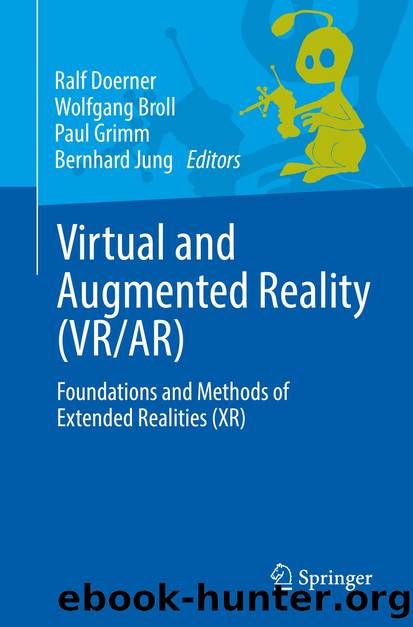Virtual and Augmented Reality (VRAR) by Unknown

Author:Unknown
Language: eng
Format: epub
ISBN: 9783030790622
Publisher: Springer International Publishing
6.5 Navigation
Navigation is a fundamental and often challenging task, as anyone will discover who is looking for a gas station in an unknown city and does not have a satellite navigation system available.
Navigation in the real world can be defined as finding oneâs way in space by determining oneâs position and calculating a route to reach the desired location as well as the necessary activities to accomplish this.
In HCI, navigation is also an important user task: users navigate websites, complex text documents or tables, and stroll through computer game worlds. In a virtual environment, navigation is a universal interaction task and of central importance. Presence in VR requires that the user can move around the world as easily as possible. In this context, a distinction is made between two sub-areas, wayfinding and traveling.
Wayfinding is the cognitive component of navigation. On a higher level of abstraction, it comprises analysis, planning and decision about paths in the virtual world. This requires spatial knowledge of the environment, techniques for planning and deciding on routes, and the use of appropriate tools such as landmarks, signs, or maps.
The goal of wayfinding is always to generate a cognitive map of the virtual world, i.e., a simplified mental representation of virtual space. The process of wayfinding is usually unconscious, and the resulting cognitive map can be different for each user. Therefore, it is difficult to develop targeted computer-based support to enable the user to acquire the necessary spatial knowledge. This knowledge can be divided into three types. Landmark knowledge includes knowledge about prominent, often unique reference points in space (landmarks), which are easier to remember than other points and can be used for locating points in space. Landmarks are easier to remember the longer a user is present in the virtual environment. Thus, they are an important tool for the development of a cognitive map. Landmarks can be integrated easily into virtual worlds, but they have to be distinguishable clearly from other objects in the environment and should be positioned in a suitable place. In AR, pathfinding is based on the usual pathfinding in reality, since the usual spatial navigation is available at any time. Nevertheless, this wayfinding in AR can be modified, e.g., by using virtual objects as landmarks, which can also support wayfinding in reality.
Route knowledge is also called procedural knowledge and describes the knowledge about the sequence of points in a scene that form a route and what actions are necessary to follow this route. Thus, route knowledge is an action-driven concept and does not necessarily require extensive visual information. In a virtual environment, tools such as a digital compass, signposts or waymarks can support the acquisition of route knowledge.
Knowledge about the topology of the environment is called overview knowledge . This knowledge is qualitatively the most extensive of the considered types and the acquisition usually takes the longest. Often existing landmark knowledge and route knowledge are used to get an overview of the virtual environment. For example, different routes and different reference points are utilized to get an overview of the virtual world through a comprehensive cognitive map.
Download
This site does not store any files on its server. We only index and link to content provided by other sites. Please contact the content providers to delete copyright contents if any and email us, we'll remove relevant links or contents immediately.
Kathy Andrews Collection by Kathy Andrews(11767)
The remains of the day by Kazuo Ishiguro(8896)
Spare by Prince Harry The Duke of Sussex(5142)
Paper Towns by Green John(5141)
The Body: A Guide for Occupants by Bill Bryson(5033)
Industrial Automation from Scratch: A hands-on guide to using sensors, actuators, PLCs, HMIs, and SCADA to automate industrial processes by Olushola Akande(5027)
Machine Learning at Scale with H2O by Gregory Keys | David Whiting(4262)
Be in a Treehouse by Pete Nelson(3999)
Never by Ken Follett(3885)
Harry Potter and the Goblet Of Fire by J.K. Rowling(3810)
Goodbye Paradise(3767)
Into Thin Air by Jon Krakauer(3350)
The Remains of the Day by Kazuo Ishiguro(3348)
Fairy Tale by Stephen King(3310)
The Cellar by Natasha Preston(3299)
The Genius of Japanese Carpentry by Azby Brown(3256)
120 Days of Sodom by Marquis de Sade(3229)
The Man Who Died Twice by Richard Osman(3042)
Drawing Shortcuts: Developing Quick Drawing Skills Using Today's Technology by Leggitt Jim(3040)
